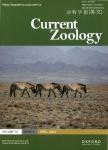Olfactory receptor gene evolution is unusually rapid across Tetrapoda and outpaces chemosensory phenotypic change
作者机构:Department of Earth&Planetary SciencePeabody Museum of Natural HistoryYale UniversityNew HavenCT06511USA
出 版 物:《Current Zoology》 (动物学报(英文版))
年 卷 期:2020年第66卷第5期
页 面:505-514页
核心收录:
学科分类:0710[理学-生物学] 07[理学] 071002[理学-动物学]
主 题:chemosensation diversifying selection olfaction olfactory bulb olfactory receptor tetrapod
摘 要:Chemosensation is the most ubiquitous sense in animals,enacted by the products of complex gene families that detect environmental chemical cues and larger-scale sensory structures that process these *** there is a general conception that olfactory receptor(OR)genes evolve rapidly,the universality of this phenomenon across vertebrates,and its magnitude,are *** supposed correlation between molecular rates of chemosensory evolution and phenotypic diversity of chemosensory systems is largely *** combine comparative genomics and sensory morphology to test whether OR genes and olfactory phenotypic traits evolve at faster rates than other genes or *** published genomes,we identified ORs in 21 tetrapods,including amphibia ns,reptiles,birds,and mammals and compared their rates of evolution to those of orthologous non-OR protein-coding *** found that,for all clades investigated,most OR genes evolve nearly an order of magnitude faster than other protein-coding genes,with many OR genes showing signatures of diversifying selection across nearly all taxa in this *** rapid rate of evolution suggests that chemoreceptor genes are in evolutionary overdrive,perhaps evolving in response to the ever-changing chemical space of the *** obtain complementary morphological data,we stained whole fixed specimens with iodine,μCT-scanned the specimens,and digitally segmented chemosensory and nonchemosensory brain *** then estimated phenotypic variation within traits and among *** we found considerable variation in chemosensory structures,they were no more diverse than nonchemosensory *** suggest chemoreceptor genes evolve quickly in reflection of an ever-changing chemical space,whereas chemosensory phe no types and processing regions are more conserved because they use a standardized or constrained architecture to receive and process a range of chemical cues.



